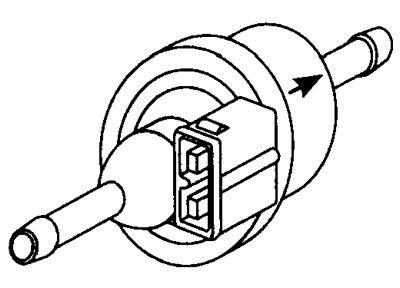Charcoal filter solenoid valve (CFSV)
Charcoal filter solenoid valve (CFSV) (see illustration 11.43) and charcoal tank are used by vehicles equipped with a catalytic converter to reduce the emission of fuel vapors into the atmosphere. The charcoal tank accumulates and absorbs fuel vapors until, under certain operating conditions, the Bosch Motronic electronic control unit opens the charcoal filter solenoid valve (CFSV). As soon as the electronic control unit activates the carbon filter solenoid valve, fuel vapors enter through the throttle valve into the engine for complete combustion.

11.43 Charcoal filter solenoid valve (CFSV)
With the ignition off, the carbon filter solenoid valve is open. As soon as the ignition is turned on, the carbon filter solenoid valve closes.
With the engine running, the solenoid valve will switch (turn on and off) electronic control unit at intervals determined by the control unit. When the engine is off and the ignition is off, the ECM will close the charcoal filter solenoid valve for a few seconds to prevent the engine from starting unexpectedly.
Charcoal Filter Solenoid Valve Voltage Values
Terminal numbers

See illustrations 11.2, 11.3, 11.4, 11.5, 11.6
Carbon filter solenoid valve resistance value
Terminal numbers
Influence of external factors
- Damaged or leaking vacuum hoses and joints
Charcoal Filter Solenoid Check (CFSV) (general check)
1. Inspect the charcoal filter solenoid valve multi-pin connector for signs of corrosion or damage.
2. Check that the connector terminal pins are installed properly and make good contact with the carbon filter solenoid valve multi-pin connector.
Checking the performance of the carbon filter solenoid valve (CFSV)
1. The carbon filter solenoid valve can be actuated through the serial port of the self-diagnosis system (SD). Familiarize yourself with the self-diagnosis function and fault codes.
2. If the carbon filter solenoid valve does not actuate, perform the following checks.
3. Turn on the ignition, check for battery voltage at the supply terminal of the carbon filter solenoid valve.
4. If there is no voltage, trace the wiring back to the main fuel injection relay.
5. Check the resistance of the carbon filter solenoid valve.
6. Disconnect the multi-pin connector of the electronic control unit and, using a jumper wire, connect the switching terminal in the multi-pin connector of the electronic control unit to ground for a very short time.
7. If the carbon filter solenoid valve works, then check the main power and ground contacts of the electronic control unit. If the tests did not reveal any malfunctions, then the electronic control unit may have failed.
8. If the charcoal filter solenoid valve does not work, check the continuity of the wiring between the charcoal filter solenoid valve and the ECU switching terminal.
9. If the wiring is OK, then the charcoal filter solenoid valve may be faulty.
Carbon filter solenoid valve resistance (CFSV)
- Disconnect the multi-pin connector and measure the resistance of the carbon filter solenoid valve between the two terminals.
